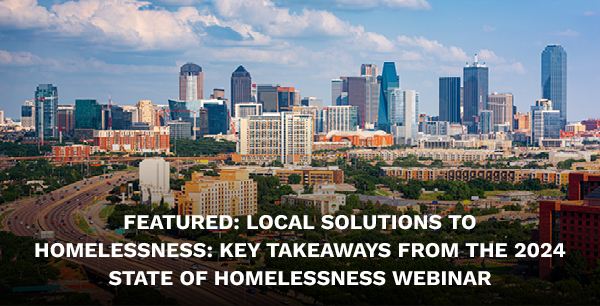|
29 October, 2024
|

|
|
PD&R Edge, an online magazine,
provides you with a snapshot view of our newly
released research, periodicals, publications, news, and commentaries on
housing
and urban development issues.
|
|

|
|
In August 2024, the National Alliance to End
Homelessness’
Homelessness Research Institute hosted an event to share
data and takeaways from its annual report, “The State
of
Homelessness.” The January 2023 HUD Point-in-Time
count
found more than 650,000 people nationwide experiencing
homelessness, a record-high count largely driven by a 23
percent rise in rates of first-time homelessness between
2019 and 2023, with a disproportionate increase in the rate
of homelessness experienced by people of color. Despite
evidence showing that the homeless response system has been
effective — fewer people returned to homelessness in
2023
compared with 2019 — the data show that affordable
housing
shortages for low-income groups continue to drive
homelessness rates.

|
|
|
|
|
PD&R LEADERSHIP

Technical Assistance
Innovations Help Communities Thrive
In the Leadership Message, Stephanie Stone, PD&R’s deputy assistant
secretary for technical assistance, discusses the transformative role of
HUD’s technical assistance initiatives in fostering innovation,
advancing
equity, and delivering meaningful outcomes in communities nationwide. HUD
collaborates closely with state and local governments, public housing
agencies, housing counseling agencies, Continuums of Care, tribes, nonprofit
organizations, and others to leverage data-driven tools and enhance
capacity-building efforts to drive innovation at every level.

|
|

TRENDING
Location Patterns of Housing Choice Voucher
Households Between 2010 and 2020
HUD began providing tenant-based rental assistance following
the passage of the Housing and Community Development Act of
1974. This form of assistance enabled low-income households
to use their assistance to seek rental housing in the
private market through a program known today as the Housing
Choice Voucher (HCV) program. Understanding locational
outcomes for participating households is important for
assessing program efficacy, with the most recent research,
covering 2010 to 2020, revealing an increasing prevalence of
HCV households with an elderly or disabled member relative
to the number of households with children, increasing
clustering of HCV households in neighborhoods with other HCV
households, and stable levels of HCV households living in
low-poverty versus high-poverty areas, though differences
persist in urban versus suburban areas and across racial and
ethnic categories.

|

IN PRACTICE
Integrating
Housing With Health Care in New Orleans,
Louisiana
In New Orleans, H3C Apartments offers 192 units and a large
community clinic in a development that combines affordable
housing with improved access to health care. Developed in
2024 by Gulf Coast Housing Partnership (GCHP) and Alembic
Community Development in partnership with Aetna, H3C is part
of GCHP’s “Health + Housing” series of
pilot projects.
As
part of the program, the Louisiana Public Health Institute
is collecting data to monitor changes in residents’
health
after moving into H3C, assessing health outcomes and
healthcare costs relative to the general population, levels
of social isolation, overall satisfaction, and
quality-of-life outcomes. H3C will allow partners to better
understand how permanent stable housing with supportive
services can improve the health and wellbeing of low-income
residents with high healthcare needs.

|
|
|
|
INTERNATIONAL & PHILANTHROPIC SPOTLIGHT

Housing and Gender-based
Violence: Responses from the United States and Canada
In North America, the United States and Canada are working to identify
solutions to the problem of gender-based violence, which the United Nations
has found to impact one in eight women and girls globally who face sexual or
physical violence. In the U.S., the Violence Against Women Act (VAWA)
included housing protections for the first time in 2005, with HUD
establishing a Gender-Based Violence Prevention Office in response.
Additional key provisions of the legislation include protection from
discrimination for survivors of violence and abuse; notification of
occupancy rights; emergency transfers; and confidentiality requirements for
survivors of domestic violence, sexual assault, dating violence, and
stalking who are applying for or living in federally assisted housing. In
Canada, although no specific national legislation addresses gender-based
violence, the nation’s Criminal Code includes provisions that cover
these
issues. Action plans being implemented by both nations offer a strategic
framework for combatting and addressing gender-based violence and providing
for the housing needs of victims.

|
|

|
PD&R Edge is now available
on Apple iOS and Android powered smartphones!
Please send your comments and
suggestions to editor@huduser.gov.
|
|
|

|
HUD USER
| P.O. Box 23268,
Washington, DC
20026-3268
Toll Free:
1-800-245-2691 | TDD:
1-800-927-7589
Local:
1-202-708-3178 | Fax:
1-202-708-9981
https://www.huduser.gov/
|
|
|










